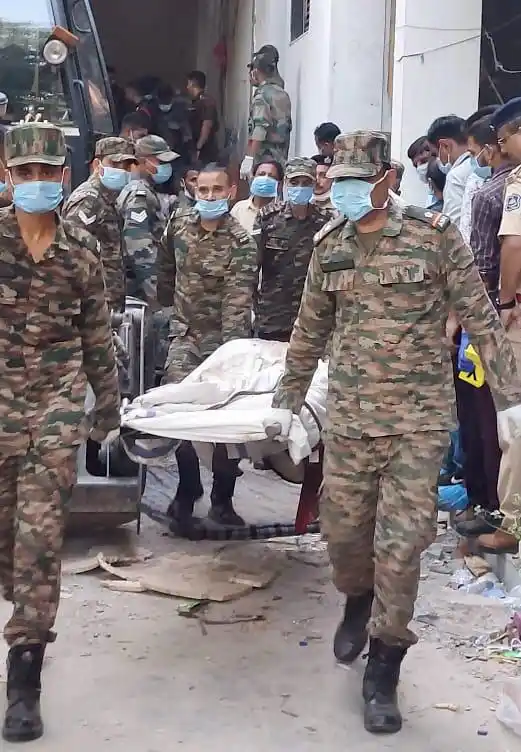
Major Madhan Kumar
35.2K subscribers
About Major Madhan Kumar
Stay tuned for Geo-political & Strategic Security updates
Similar Channels
Swipe to see more
Posts

Raksha Mantri Shri Rajnath Singh has extended deepest condolences to the families who have lost their loved ones in a tragic plane crash in Ahmedabad, Gujarat. “My thoughts and prayers are with the families of the passengers and the crew. Praying for the speedy recovery of those who are injured,” he said in a post on X. https://x.com/rajnathsingh/status/1933170318102638975?s=46

Indian Army relief columns from Golden Katar Division have been activated and rushed to the Ahmedabad Plane Crash site for assisting civil authorities in humanitarian and disaster relief operations. Indian Army stands in solidarity with the crash victims and their families in this hour of grief. https://x.com/adgpi/status/1933167174660567435?s=46


*India's Strategic Acquisition of the Su-57: Bridging the Airpower Gap* The decision to acquire Russia's Su-57, a 5th generation aircraft, marks a pivotal moment for India's air defense capabilities. This move, made after the successful "Operation Sindhoor," aims to bolster the Indian Air Force amidst evolving geopolitical landscapes, particularly with Pakistan's continued procurement of China's J-35 stealth aircraft. This acquisition is not merely about adding a new fighter jet to the fleet; it's a strategic calculus involving indigenous production, technological integration, and filling critical operational gaps. *Su-57's Design and Performance Analysis* The Su-57, despite being classified as a 5th generation fighter, possesses distinct characteristics that set it apart from its Western counterparts like the F-35 or J-20. While it may not achieve the same level of stealth as the F-35, its engine performance and overall maneuverability are touted as superior to the J-20. Sukhoi, with its extensive experience in manufacturing warplanes, brings a legacy of robust design and aerodynamic efficiency. In contrast, Chengdu, the manufacturer of the J-20, is a relatively newer player in the high-performance aircraft segment, often relying on technology transfers and reverse-engineering. The Su-57's aerodynamic design, maneuverability, and engine performance are considered its strong suit, though its stealth features are an area where Russian technology lags. This is partly attributed to China's alleged access to F-35 stealth coating information, which has allowed them to achieve comparable stealth capabilities with the J-20. *Engine and Stealth Evolution* A key aspect of the Su-57's development has been the evolution of its engine. The initial engine, the AL-41F, was considered a 4.5 generation engine. However, the Russians are now transitioning to the AL-51 series, a true 5th generation engine. This new engine boasts significantly higher thrust, increasing from 147kN to 167kN, and is capable of supercruising with a fully loaded Su-57. Furthermore, a notable shift has occurred in thrust vectoring technology. While earlier designs featured 3D thrust vectoring for enhanced maneuverability, the Russians are now exploring 2D thrust vectoring for the Su-57. This change is driven by stealth considerations, as 2D thrust vectoring produces fewer infrared waves, making the aircraft less detectable. This approach mirrors that of the F-22 Raptor, which also utilizes 2D thrust vectoring for stealth. The success of this implementation on the Su-57 remains to be fully determined, but the potential for improved stealth is a significant factor. *Weaponry and Internal Systems* The Su-57's design allows for substantial internal and external weapon carriage, a significant advantage over smaller 5th generation aircraft like the F-22 and F-35. The F-22 is primarily limited to air-to-air weapons, and the F-35 to bombs and anti-radiation missiles. In contrast, the larger airframe of the Su-57 accommodates four internal weapon bays, enabling it to carry a wider array of larger weapons. However, for the export variant, the Su-57E, Russia has indicated that it will be equipped with the AL-41 engine, a 4.5 generation engine, which presents a notable drawback. Our expectation is for the AL-51 engine to be integrated into the export variant as well. Furthermore, we emphasize the need for indigenization of critical internal systems. This includes the AESA radar, fire control systems, and avionics, all of which should be domestically manufactured and compatible with Indian systems, such as the gallium nitride-based AESA radar. The aircraft must also be seamlessly integrated into network-centric warfare environments and capable of communicating with drones manufactured by Hindustan Aeronautics Limited. The electronic warfare jammers and AESA radars, especially for air superiority and suppression of enemy air defense systems (SEAD), must also be Indian systems. This necessitates the integration of the Astra family of AESA radars and AWACS killer radars, along with the Rudram series of anti-radiation missiles. This requires Russia to provide the necessary source code and support for comprehensive integration. *Strategic Manufacturing and Future Implications* A crucial aspect of this acquisition is the emphasis on localized manufacturing. While the airframe and engine will initially come from Russia, our strategic goal is for the Su-57 to be manufactured and assembled in India. This is particularly vital given past challenges with spare part availability for existing Russian-made aircraft. Indigenous production of the Su-57 would mitigate reliance on external supply chains and ensure operational continuity. Russia has already expressed willingness for local production and export from India, though their stance on the AL-51 engine's local assembly is yet to be clarified. Russia's precedent of providing extensive upgrades for India's Su-30MKI variants, unmatched by any other country, suggests a strong willingness to cooperate on technology transfer. Furthermore, Russia has affirmed that India will have full freedom to integrate its indigenous weapon systems onto the Su-57. This agreement is a significant win, allowing for the integration of Indian weapons and systems. However, this strategic acquisition must not come at the expense of India's indigenous Advanced Medium Combat Aircraft (AMCA) program. Funding and development for AMCA must remain unaffected, as the Su-57 is intended to fill a crucial gap in our airpower capabilities. While the Su-57 may not be a true stealth fighter in the same vein as some Western counterparts, its performance, particularly its lower radar cross-section compared to the Rafale, makes it a valuable asset. The indigenous manufacturing of the Su-57 will also provide a significant boost to India's private aeronautical industry. *---By Blaze,Team MMK*

12 June 2025.*DEFENCE UPDATE* 1. *US Top General Michael Kurilla*: Ties with India cannot cost ties with Pakistan—The US CENTCOM commander emphasized that while US-India relations are important, they will not come at the expense of longstanding ties with Pakistan. 2. *Failed Marshal to Visit US*: Pakistan’s Air Force chief is visiting the US to attend the US Army’s 250th anniversary celebrations in Washington, DC. 3. *India-US conduct maiden Special Forces drill 'Tiger Claw'*: The first independent special forces exercise between the Indian and US Air Forces, called Tiger Claw 2025, concluded in North India to boost interoperability. 4. *8th edition of Exercise Shakti between India & France*: The Indo-French joint military exercise Shakti will be held from June 18 in France, marking the 8th edition of this bilateral drill. 5. *PASSEX 2025*: Indian and UK Navy conduct joint exercise in North Arabian Sea—A high-intensity passage exercise was conducted to enhance naval cooperation between the two countries. 6. *ADA to issue the RFP for the production of AMCA prototype next week*: The Aeronautical Development Agency will soon release a Request for Proposal for making the AMCA stealth fighter prototype, with a pre-bid meeting in 15 days. 7. *Safran & Rolls Royce offer 100% Transfer of Technology & Intellectual Property rights to India for AMCA's 120 KN Engine*: Both companies are offering full technology and IP rights to India for the next-generation 120kN engine for the AMCA program. 8. *India is considering to order 1-2 more units of S-400 system*: India may order up to two additional S-400 air defense systems beyond the five regiments already contracted. 9. *India's Prachand to integrate VSHORAD for Anti-UAV roles*: The Prachand light combat helicopter will be upgraded with very short-range air defense (VSHORAD) missiles to counter UAV threats. 10. *1st consignment of Sukhoi-30 brake parachutes leaves for Malaysia*: The first batch of brake parachutes for the Su-30, made at the Ordnance Equipment Factory in Hazratpur, UP, has been shipped to Malaysia. 11. *Solar Defence completes trial of Rudrastra Hybrid VTOL UAV*: Solar Defence has successfully tested its Rudrastra hybrid vertical takeoff and landing UAV, achieving a range of over 170 km and 1.5 hours endurance. 12. *GRSE signs contract with GSI for two coastal research vessels*: Garden Reach Shipbuilders & Engineers has signed a contract to build two coastal research ships for the Geological Survey of India. 13. *Dassault to outsource Rafale Wings Manufacturing to Indian Firm*: Dassault Aviation is in advanced talks to outsource Rafale fighter jet wing production to an Indian company, with an official announcement expected soon. 14. *MoD to evaluate Russian Su-57E production offer for IAF*: The Ministry of Defence will assess Russia’s proposal to supply or locally produce 40–60 Su-57E stealth fighters for the Indian Air Force, including technology transfer and joint engine development.

FYI https://x.com/saikirankannan/status/1933372005375791310?t=tUb49XfYu3FKtU6HPKbgfQ&s=19

https://x.com/saikirankannan/status/1933366346915693024?t=84dXboU8JGNKZ_8aeWf9vA&s=08


















